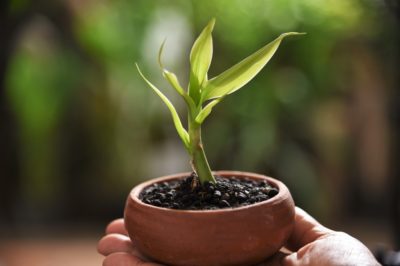Caring for Lucky Bamboo
Lucky bamboo is an easy-care plant and one of the few that can be grown indoors in plain water. For good health it needs:
- Good quality water that is changed at least every two weeks.
- Bright indirect light – direct sunlight can burn leaves.
- Minimal fertilizer; use liquid fertilizer for water-grown plants and timed-release pellets for plants in soil.
- Good drainage if grown in soil.
Too Much Fertilizer
Over-fertilization is probably the most common reason for yellow leaves on lucky bamboo. When you first buy a commercially-grown plant, it may have been regularly fertilized to promote fast growth. Let it go without fertilizer for three or four months to prevent over-fertilization. Don’t use more than one drop of liquid fertilizer per month and decrease if leaves look yellow.
Chemical Damage
Tap water usually contains chlorine and may also contain fluoride or other chemicals. In addition, hard water may be chemically treated with water-softeners. Lucky bamboo is sensitive to all of these chemicals. It either won’t grow well or will begin to show signs of damage such as yellow leaves. Eventually the stem may turn yellow as well.
Contaminated Water
The water in which you grow your lucky bamboo provides a medium for molds and bacteria. These can infect the roots and stems of your plant. The infection affects the lucky bamboo’s ability to absorb nutrients and causes physical damage to the cells. The plant’s leaves will yellow first; in severe infections, the stems will also yellow and roots will begin to rot.
Saving the Plant
In the early stages, lucky bamboo with yellow leaves may be saved by correcting the problem. Hold fertilizer, change the water more frequently and use better quality water. If all else fails, take cuttings from the healthiest stems and propagate new plants. You should realize that this is a gamble, since the plant already has problems.
Preventing Problems
You can usually avoid yellowed leaves in lucky bamboo with good management. Use rainwater or distilled water and change it every two weeks. Thoroughly clean the container and rinse with dilute bleach. Rinse very well with plain water after cleaning and allow the container to air dry overnight. Limit fertilizer to recommended amounts. Keep the plant out of direct sunlight.
